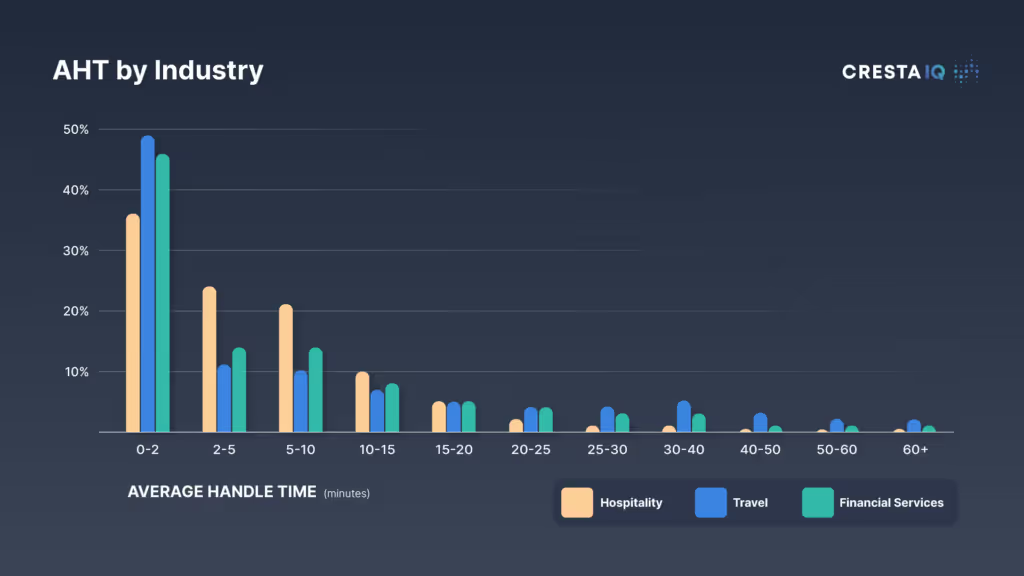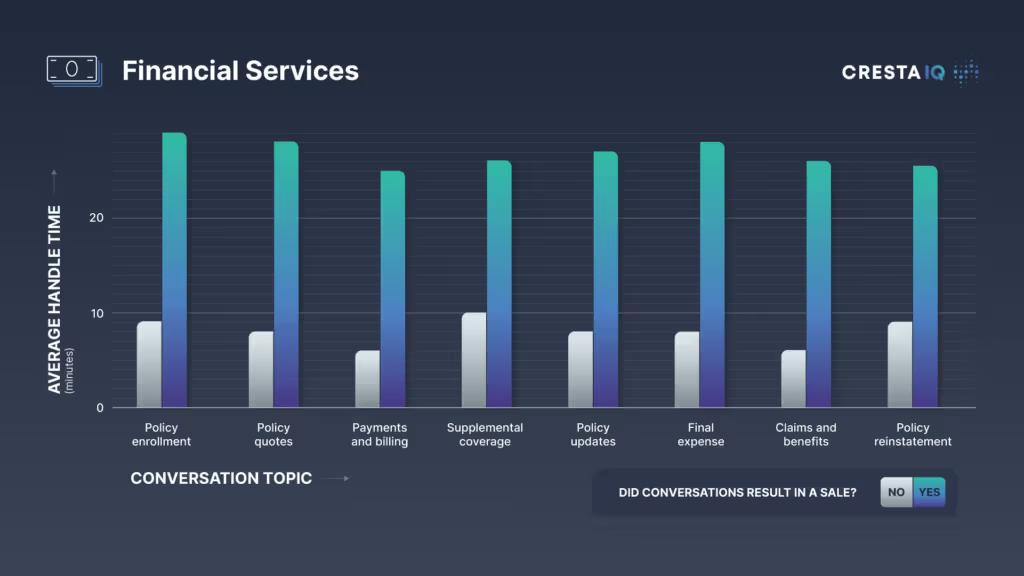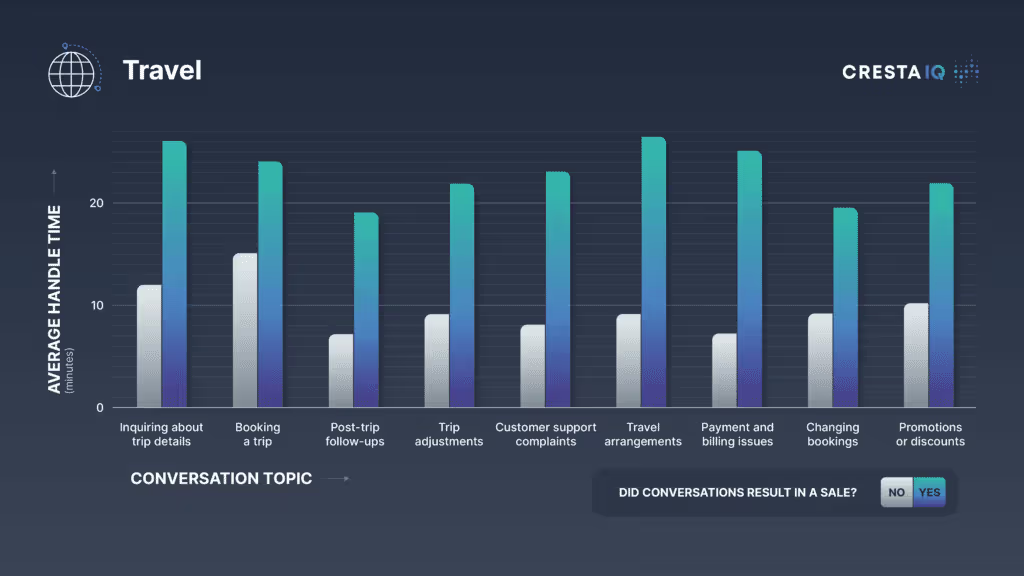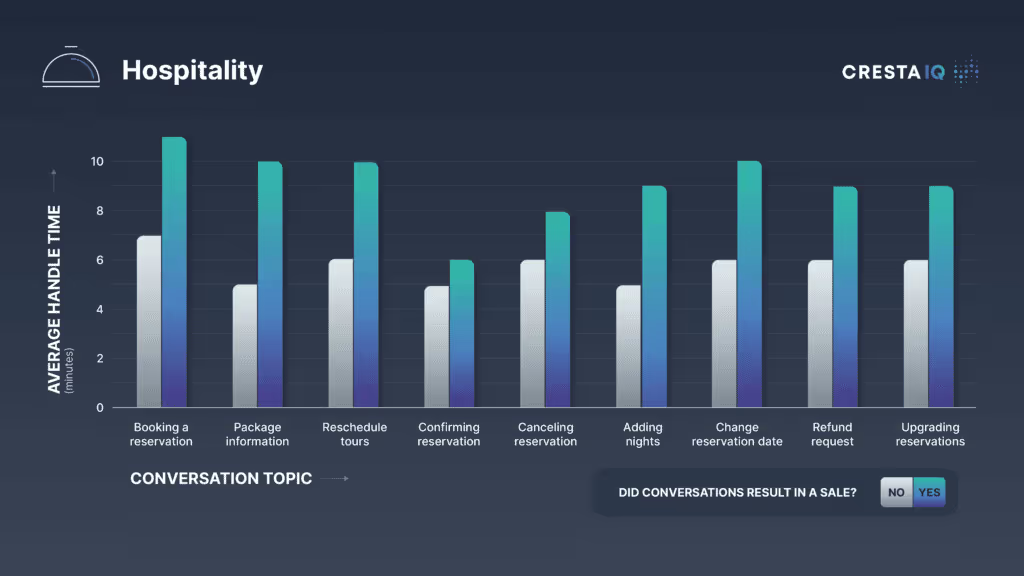Recently, I found myself on the phone with a travel agent booking an upcoming trip. From the moment the agent answered, it felt distinctly like I was being rushed through a predetermined checklist.“How can I help you?”“You can find the information on our website.”“Anything else I can help you with today?”Despite being ready to book, the agent’s haste to rush me off the phone made the whole experience feel transactional and impersonal.This got me thinking...What if agents were incentivized to take more time with customers? What if, even with efficiency goals, contact centers also prioritized deeper conversations, discovery to uncover opportunities, and thorough answers?Recognizing the value of these richer, more engaging interactions, I decided to put some heads together at Cresta to dive deeper into this topic. Which brings me to…
Introducing Cresta IQ
Welcome to the inaugural post of Cresta IQ, our new data-backed series where we dig into insights and trends in the contact center. Our mission is to analyze anonymized data around customer-facing conversations to uncover actionable insights, and share these findings to help you elevate your contact center operations and drive meaningful change in your organization.We’ll be publishing these regularly, so follow along on LinkedIn so you don’t miss a single post.In today’s installment of Cresta IQ, we ran an analysis on tens of thousands of conversations to better understand Average Handle Time (AHT) benchmarks in contact centers across three different industries - Travel, Hospitality, and Financial Services - and to explore how AHT impacts and intersects with revenue.
But first, what is Average Handle Time?
If you’ve spent any time in a contact center, you’ve heard those three magic words: Average Handle Time. This metric has been key to understanding contact center operations for years. But hold onto your headsets, because we're about to shake things up a bit.For the uninitiated, AHT measures how long it takes to wrap up a customer transaction. This includes hold time, talk time, and all of the necessary after-call work - such as documentation, customer updates, and any other required administrative tasks.

Historically, the priority has been on lowering AHT, for a number of reasons. A relatively low AHT has long been the gold standard in evaluating the efficiency of your contact center, assessing agent performance, and identifying training and coaching needs.To give you a sense of AHT benchmarks, here's a chart that illustrates what AHT distributions look like across total conversations in the three industries we analyzed.

Up to 75% of the total contact center operating budget is allocated to agent staffing, training, and salaries. When agents can deliver on shorter calls, fewer agents are required to handle call volume. The shorter the calls, the more customers your agents can handle, leading to cost savings.When agents can deliver on shorter calls, fewer agents are required to handle call volume. The shorter the calls, the more customers your agents can handle, leading to cost savings. Shorter calls also cut down on wait times for end customers, resulting in higher CSAT. Essentially, there are many reasons the contact center has prioritized lowering this metric, most of it largely focused on cost reductions.But what if you shifted your focus from cost savings to profit generation?
Move too fast and you might miss something
Now, before you start looking for ways to slash AHT indiscriminately, let’s add some nuance into this conversation. Understanding why there’s variance in AHT - and what those variations can reveal about these conversations - is critical. Sometimes, higher AHT is actually a good thing.Those longer calls often indicate that your agents are having meaningful, value-rich conversations - the kind that lead to sales, brand loyalty, and happy customers. Cutting calls short might save time in the short term, but it can also mean missing out on serious opportunities to build customer relationships and drive revenue.Without having 100% visibility into what’s happening in your customer interactions, the default tends to be a one-size-fits-all approach to thinking about AHT.Our data shows that these longer conversations - sometimes especially the ones that you might not expect - are often packed with revenue opportunities. Looking at AHT solely from the vantage point of driving it down and reducing it can deal a heavy blow to your business’ top line.
Reaping the rewards of taking it slow
Below, you can see a breakdown of Average Handle Time across a variety of different conversation topics, which fall into both care and sales, across the three different industries. We further cut this data by whether or not the conversations lead to a positive outcome, a sale.

One of the first things that stood out to me: in an industry where the average AHT is under seven minutes, the conversations that are actually resulting in positive sales are substantially longer, clocking in at well over 20 minutes.

Above is the Travel industry, where we looked across a number of different conversation topics, including ‘booking a trip’, ‘inquiring about trip details’, ‘travel arrangements’ and more.Across the board, we found that when there are positive outcomes that result in sales, conversations with customers are longer. Putting in the extra time to understand a customers' needs and concerns can not only prevent customer churn, but can also result in a sale. Even in calls specifically about ‘customer support complaints’, where presumably the customer is calling in with a negative experience, the ones with higher AHT resulted in a sale after the agent was able to turn it around.

Want to turn more service conversations into sales conversations?Download this actionable playbook!

Some categories of calls, such as ‘cancel reservation’, showed up in both positive (revenue-generating) outcomes and negative outcomes. The big difference was that those that resulted in revenue involved a higher AHT, indicating that these longer calls are the ones that drove sales and saved customer relationships.
Slow and steady wins the deal
When it comes to these longer conversations, below are three key areas to optimize around and coach to, to ensure that those minutes are worth it. These best practices are proven to drive sales and result in positive outcomes.As we dive in, it’s important to note that these all involve actions for the agent that add length to the call - and, in these cases, that’s for the best.
Discovery
This category is all about agents’ abilities to set expectations, and deeply understand the customers’ needs and pain points. This could include things like asking clarifying questions, in which the agent is really trying to understand the customer, why they’re calling, and how to help in a truly personalized way. When agents know how to navigate discovery, they are able to ‘lose’ fast, and win efficiently.
Overcoming objections
This category refers to an agent’s ability to alleviate customer concerns and continue to move the deal to move forward in spite of them. This is an opportunity to establish or further strengthen a foundation of trust with the customer, building rapport and urgency to close the sale. Best-in-class contact centers overcome objections by acting as an advisor to the customer, and not being defensive in the face of conflict.
Assumptive statements
Here, agents use confident and assumptive language that helps guide customers to the desired outcome, whatever that may be. Again, this helps to build trust for the customer and to inspire brand and product loyalty.What else do we know about these key best practices? Agents who are great at these three skills are proven to earn 2.1x more revenue and convert 1.8x better than their peers. And while that does involve longer, deeper conversations, the increase in revenue and conversions speak for themselves.
The role of generative AI
Now, you might be wondering, how do we strike the right balance? Enter generative AI. This tech isn’t just for cutting down talk time — it’s for enhancing the quality of those conversations. AI can prompt agents in real time to follow behaviors that are proven to drive sales and build relationships. It helps classify calls and analyze what’s happening, so leadership gets clearer visibility into why some calls are longer and more successful - and how to optimize the right conversations.Generative AI gives agents the time and tools to focus on what matters. It’s not about rushing through calls; it’s about optimizing for conversations that move the needle.Companies should be honing in on the behaviors that lead to revenue and sustained customer loyalty, like asking the right discovery questions, creating urgency, and building strong customer relationships.
Let’s wrap this up
So, next time someone tells you to cut down your Average Handle Time, think twice. Efficiency is critical in the contact center - but not at the cost of quality conversations that impact the bottom line. Embrace the longer calls when they matter, and let generative AI guide your agents to success.Want more insights on how to turn your contact center into a profit center? Check out our 3-step playbook for transforming your contact center into a revenue-driving powerhouse.Follow Cresta to stay updated with the latest research and insights.







